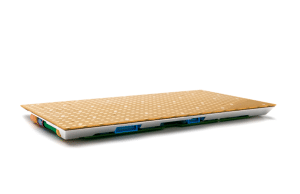Latest News
[Via Satellite 10-23-2015] Phasor has completed the technology for its flat, Electronically Steered Antenna (ESA), and is now shifting into a new stage focused on making its products ready for various markets. The company’s antenna, which has been under development for more than five years, has completed successful demonstrations of both transmit and receive technology with what the company described as “outstanding results.”
“We’ve completed the core technology Research and Development (R&D) phase and are now in the productization phase, which is taking all this great technology that now is ready to go and packaging it the correct way for the three mobile broadband use cases: aeronautical, maritime and land-mobile,” Dave Helfgott, CEO of Phasor, told Via Satellite. “I would say that we are almost through Technological Readiness Level (TRL) 6 and approaching TRL 7. Alpha tests should be completed early next year, followed quickly by in field beta testing.”
Phasor is poised to challenge mechanically steered antennas in mobility markets with its nimble phased array product. Recent partnerships such as an exclusive agreement with Intelsat for aviation antennas, and a maritime partnership with OmniAccess have turned the company into a near-overnight parvenu often compared with the likes of Kymeta. The modules that comprise Phasor’s product fit inside two Printed Circuit Boards (PCBs), with the whole antenna measuring less than about 2.5 centimeters (1 inch) thin. While phased array antennas have been around for decades, much of their use has been in military applications, where the technology is too cost prohibitive to see widespread commercial use. Phasor has patented many technologies related to its own phased array design that, according to Helfgott, make its antennas much more applicable to the commercial market.
“A critical development was getting the entire RF chain onto an Application-Specific Integrated Circuit (ASIC) chip. When a signal hits our array on a patch antenna, it is immediately converted at the ASIC and comes out in baseband. That gives us an affordable architecture to scale up,” he said. “Relative to military phased array, we are talking orders of magnitude more affordable — in the same range as your high-end mechanically steered antenna.”
Helfgott believes Phasor will serve different markets than Kymeta, which is developing a phased array antenna based on meta-materials science. He also said Kymeta’s approach is very different compared to Phasor’s, which uses “beam forming chips married with patch antennas,” along with industry-standard processes and materials.
Through near-field and far-field testing, Phasor measured the antenna’s performance as it moves, as it is able to acquire a signal, and its ability to beam form and transmit a signal. The company has also conducted off-satellite receive tests and, according to Helfgott, off-satellite transmit tests are scheduled to take place very soon. He added that the company will have at least three partners for the three aforementioned use cases to trial the antennas for an extended amount of time prior to product launch. Helfgott said learnings gleaned from this testing will determine the exact date of product launch, which is tentatively scheduled for mid-2017.
Phasor’s ESAs employ a modular design where panels can connect to each other to scale up to any size. If a radiating-element on the array goes down, the antenna can continue to operate, albeit at a slightly diminished capacity. Additionally, the antennas are very responsive.
“Electronically steerable antennas form these virtual beams, and each active element communicates with itself and all the other elements to determine very quickly the direction of the strongest signal and then each adjusts their relative position,” explained Helfgott. “That’s how a beam in milliseconds is constantly reforming itself. Our antenna does that. A parabolic antenna doesn’t.”
Phasor’s ESA is designed to work in Ku-band with traditional geostationary Fixed Satellite Service (GEO-FSS) satellites, with the spot-beams of High Throughput Satellite (HTS) systems, and with Non-Geostationary Orbiting (NGSO) spacecraft such as Low or Medium Earth Orbit (LEO/MEO) constellations. In addition to seeing interest for its debut product — including extensive interest from today’s LEO pioneers — Helfgott said there is demand for ESAs in other frequencies, which is something Phasor is evaluating.
“We’ve been asked to look at developments in other frequencies including Ka-, X- and C-band. Our technology is transferable to other frequencies, it just requires a different set of ASICs, and a different type of panel geometry — the layout of the patch antennas on the actual array — but everything else is the same. So we launch in Ku, but we are carefully assessing what our next product will be on the heels of that,” he said.
Another consideration was space-qualifying the antennas for use on satellites in orbit, but Helfgott said Phasor has no current plans to pursue this as it is currently occupied by existing endeavors.
Get the latest Via Satellite news!
Subscribe Now